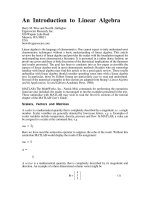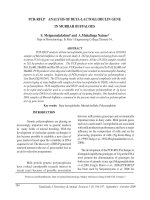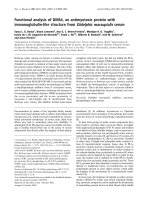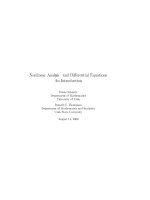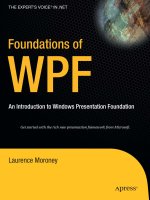ANALYSIS OF STRUCTURES: AN INTRODUCTION INCLUDING NUMERICAL METHODS pdf
Bạn đang xem bản rút gọn của tài liệu. Xem và tải ngay bản đầy đủ của tài liệu tại đây (12.89 MB, 626 trang )
P1: TIX/XYZ P2: ABC
JWST071-FM JWST071-Waas July 4, 2011 11:3 Printer Name: Yet to Come
ANALYSIS OF
STRUCTURES
P1: TIX/XYZ P2: ABC
JWST071-FM JWST071-Waas July 4, 2011 11:3 Printer Name: Yet to Come
ANALYSIS OF
STRUCTURES
AN INTRODUCTION INCLUDING
NUMERICAL METHODS
Joe G. Eisley
Anthony M. Waas
College of Engineering
University of Michigan, USA
A John Wiley & Sons, Ltd., Publicatio
n
P1: TIX/XYZ P2: ABC
JWST071-FM JWST071-Waas July 4, 2011 11:3 Printer Name: Yet to Come
This edition first published 2011
C
2011 John Wiley & Sons, Ltd
Registered office
John Wiley & Sons Ltd, The Atrium, Southern Gate, Chichester, West Sussex, PO19 8SQ, United Kingdom
For details of our global editorial offices, for customer services and for information about how to apply for
permission to reuse the copyright material in this book please see our website at www.wiley.com.
The right of the author to be identified as the author of this work has been asserted in accordance with the Copyright,
Designs and Patents Act 1988.
All rights reserved. No part of this publication may be reproduced, stored in a retrieval system, or transmitted, in any
form or by any means, electronic, mechanical, photocopying, recording or otherwise, except as permitted by the UK
Copyright, Designs and Patents Act 1988, without the prior permission of the publisher.
Wiley also publishes its books in a variety of electronic formats. Some content that appears in print may not be
available in electronic books.
Designations used by companies to distinguish their products are often claimed as trademarks. All brand names and
product names used in this book are trade names, service marks, trademarks or registered trademarks of their
respective owners. The publisher is not associated with any product or vendor mentioned in this book. This
publication is designed to provide accurate and authoritative information in regard to the subject matter covered. It is
sold on the understanding that the publisher is not engaged in rendering professional services. If professional advice
or other expert assistance is required, the services of a competent professional should be sought.
Library of Congress Cataloging-in-Publication Data
Eisley, Joe G.
Analysis of structures : an introduction including numerical methods / Joe G. Eisley, Anthony M. Waas.
p. cm.
Includes bibliographical references and index.
ISBN 978-0-470-97762-0 (cloth)
1. Structural analysis (Engineering)–Mathematics. 2. Numerical analysis. I. Waas, Anthony M. II. Title.
TA646.W33 2011
624.1
71–dc22
2011009723
A catalogue record for this book is available from the British Library.
Print ISBN: 9780470977620
E-PDF ISBN: 9781119993285
O-book ISBN: 9781119993278
E-Pub ISBN: 9781119993544
Mobi ISBN: 9781119993551
Typeset in 9/11pt Times by Aptara Inc., New Delhi, India
P1: TIX/XYZ P2: ABC
JWST071-FM JWST071-Waas July 4, 2011 11:3 Printer Name: Yet to Come
We would like to dedicate this book to our families.
To Marilyn, Paul and Susan
—Joe
To Dayamal, Dayani, Shehara and Michael
—Tony
P1: TIX/XYZ P2: ABC
JWST071-FM JWST071-Waas July 4, 2011 11:3 Printer Name: Yet to Come
Contents
About the Authors xiii
Preface xv
1 Forces and Moments 1
1.1 Introduction 1
1.2 Units 1
1.3 Forces in Mechanics of Materials 3
1.4 Concentrated Forces 4
1.5 Moment of a Concentrated Force 9
1.6 Distributed Forces—Force and Moment Resultants 19
1.7 Internal Forces and Stresses—Stress Resultants 27
1.8 Restraint Forces and Restraint Force Resultants 32
1.9 Summary and Conclusions 33
2 Static Equilibrium 35
2.1 Introduction 35
2.2 Free Body Diagrams 35
2.3 Equilibrium—Concentrated Forces 38
2.3.1 Two Force Members and Pin Jointed Trusses 38
2.3.2 Slender Rigid Bars 44
2.3.3 Pulleys and Cables 49
2.3.4 Springs 52
2.4 Equilibrium—Distributed Forces 55
2.5 Equilibrium in Three Dimensions 59
2.6 Equilibrium—Internal Forces and Stresses 62
2.6.1 Equilibrium of Internal Forces in Three Dimensions 65
2.6.2 Equilibrium in Two Dimensions—Plane Stress 69
2.6.3 Equilibrium in One Dimension—Uniaxial Stress 70
2.7 Summary and Conclusions 70
3 Displacement, Strain, and Material Properties 71
3.1 Introduction 71
3.2 Displacement and Strain 71
3.2.1 Displacement 72
3.2.2 Strain 72
3.3 Compatibility 76
P1: TIX/XYZ P2: ABC
JWST071-FM JWST071-Waas July 4, 2011 11:3 Printer Name: Yet to Come
viii Contents
3.4 Linear Material Properties 77
3.4.1 Hooke’s Law in One Dimension—Tension 77
3.4.2 Poisson’s Ratio 81
3.4.3 Hooke’s Law in One Dimension—Shear in Isotropic Materials 82
3.4.4 Hooke’s Law in Two Dimensions for Isotropic Materials 83
3.4.5 Generalized Hooke’s Law for Isotropic Materials 84
3.5 Some Simple Solutions for Stress, Strain, and Displacement 85
3.6 Thermal Strain 89
3.7 Engineering Materials 90
3.8 Fiber Reinforced Composite Laminates 90
3.8.1 Hooke’s Law in Two Dimensions for a FRP Lamina 91
3.8.2 Properties of Unidirectional Lamina 94
3.9 Plan for the Following Chapters 96
3.10 Summary and Conclusions 98
4 Classical Analysis of the Axially Loaded Slender Bar 99
4.1 Introduction 99
4.2 Solutions from the Theory of Elasticity 99
4.3 Derivation and Solution of the Governing Equations 109
4.4 The Statically Determinate Case 116
4.5 The Statically Indeterminate Case 129
4.6 Variable Cross Sections 136
4.7 Thermal Stress and Strain in an Axially Loaded Bar 142
4.8 Shearing Stress in an Axially Loaded Bar 143
4.9 Design of Axially Loaded Bars 145
4.10 Analysis and Design of Pin Jointed Trusses 149
4.11 Work and Energy—Castigliano’s Second Theorem 153
4.12 Summary and Conclusions 162
5 A General Method for the Axially Loaded Slender Bar 165
5.1 Introduction 165
5.2 Nodes, Elements, Shape Functions, and the Element Stiffness Matrix 165
5.3 The Assembled Global Equations and Their Solution 169
5.4 A General Method—Distributed Applied Loads 182
5.5 Variable Cross Sections 196
5.6 Analysis and Design of Pin-jointed Trusses 202
5.7 Summary and Conclusions 211
6 Torsion 213
6.1 Introduction 213
6.2 Torsional Displacement, Strain, and Stress 213
6.3 Derivation and Solution of the Governing Equations 216
6.4 Solutions from the Theory of Elasticity 225
6.5 Torsional Stress in Thin Walled Cross Sections 229
6.6 Work and Energy—Torsional Stiffness in a Thin Walled Tube 231
6.7 Torsional Stress and Stiffness in Multicell Sections 239
6.8 Torsional Stress and Displacement in Thin Walled Open Sections 242
P1: TIX/XYZ P2: ABC
JWST071-FM JWST071-Waas July 4, 2011 11:3 Printer Name: Yet to Come
Contents ix
6.9 A General (Finite Element) Method 245
6.10 Continuously Variable Cross Sections 254
6.11 Summary and Conclusions 255
7 Classical Analysis of the Bending of Beams 257
7.1 Introduction 257
7.2 Area Properties—Sign Conventions 257
7.2.1 Area Properties 257
7.2.2 Sign Conventions 259
7.3 Derivation and Solution of the Governing Equations 260
7.4 The Statically Determinate Case 271
7.5 Work and Energy—Castigliano’s Second Theorem 278
7.6 The Statically Indeterminate Case 281
7.7 Solutions from the Theory of Elasticity 290
7.8 Variable Cross Sections 300
7.9 Shear Stress in Non Rectangular Cross Sections—Thin Walled Cross Sections 302
7.10 Design of Beams 309
7.11 Large Displacements 313
7.12 Summary and Conclusions 314
8 A General Method (FEM) for the Bending of Beams 315
8.1 Introduction 315
8.2 Nodes, Elements, Shape Functions, and the Element Stiffness Matrix 315
8.3 The Global Equations and their Solution 320
8.4 Distributed Loads in FEM 327
8.5 Variable Cross Sections 341
8.6 Summary and Conclusions 345
9 More about Stress and Strain, and Material Properties 347
9.1 Introduction 347
9.2 Transformation of Stress in Two Dimensions 347
9.3 Principal Axes and Principal Stresses in Two Dimensions 350
9.4 Transformation of Strain in Two Dimensions 354
9.5 Strain Rosettes 356
9.6 Stress Transformation and Principal Stresses in Three Dimensions 358
9.7 Allowable and Ultimate Stress, and Factors of Safety 361
9.8 Fatigue 363
9.9 Creep 364
9.10 Orthotropic Materials—Composites 365
9.11 Summary and Conclusions 366
10 Combined Loadings on Slender Bars—Thin Walled Cross Sections 367
10.1 Introduction 367
10.2 Review and Summary of Slender Bar Equations 367
10.2.1 Axial Loading 367
10.2.2 Torsional Loading 369
10.2.3 Bending in One Plane 370
10.3 Axial and Torsional Loads 372
10.4 Axial and Bending Loads—2D Frames 375
P1: TIX/XYZ P2: ABC
JWST071-FM JWST071-Waas July 4, 2011 11:3 Printer Name: Yet to Come
x Contents
10.5 Bending in Two Planes 384
10.5.1 When I
yz
is Equal to Zero 384
10.5.2 When I
yz
is Not Equal to Zero 386
10.6 Bending and Torsion in Thin Walled Open Sections—Shear Center 393
10.7 Bending and Torsion in Thin Walled Closed Sections—Shear Center 399
10.8 Stiffened Thin Walled Beams 405
10.9 Summary and Conclusions 416
11 Work and Energy Methods—Virtual Work 417
11.1 Introduction 417
11.2 Introduction to the Principle of Virtual Work 417
11.3 Static Analysis of Slender Bars by Virtual Work 421
11.3.1 Axially Loading 421
11.3.2 Torsional Loading 426
11.3.3 Beams in Bending 427
11.3.4 Combined Axial, Torsional, and Bending Behavior 430
11.4 Static Analysis of 3D and 2D Solids by Virtual Work 430
11.5 The Element Stiffness Matrix for Plane Stress 433
11.6 The Element Stiffness Matrix for 3D Solids 436
11.7 Summary and Conclusions 437
12 Structural Analysis in Two and Three Dimensions 439
12.1 Introduction 439
12.2 The Governing Equations in Two Dimensions—Plane Stress 440
12.3 Finite Elements and the Stiffness Matrix for Plane Stress 445
12.4 Thin Flat Plates—Classical Analysis 452
12.5 Thin Flat Plates—FEM Analysis 455
12.6 Shell Structures 459
12.7 Stiffened Shell Structures 466
12.8 Three Dimensional Structures—Classical and FEM Analysis 470
12.9 Summary and Conclusions 477
13 Analysis of Thin Laminated Composite Material Structures 479
13.1 Introduction to Classical Lamination Theory 479
13.2 Strain Displacement Equations for Laminates 480
13.3 Stress-Strain Relations for a Single Lamina 482
13.4 Stress Resultants for Laminates 486
13.5 CLT Constitutive Description 489
13.6 Determining Laminae Stress/Strains 492
13.7 Laminated Plates Subject to Transverse Loads 493
13.8 Summary and Conclusion 498
14 Buckling 499
14.1 Introduction 499
14.2 The Equations for a Beam with Combined Lateral and Axial Loading 499
14.3 Buckling of a Column 504
14.4 The Beam Column 512
14.5 The Finite Element Method for Bending and Buckling 515
14.6 Buckling of Frames 524
P1: TIX/XYZ P2: ABC
JWST071-FM JWST071-Waas July 4, 2011 11:3 Printer Name: Yet to Come
Contents xi
14.7 Buckling of Thin Plates and Other Structures 524
14.8 Summary and Conclusions 527
15 Structural Dynamics 529
15.1 Introduction 529
15.2 Dynamics of Mass/Spring Systems 529
15.2.1 Free Motion 529
15.2.2 Forced Motion—Resonance 540
15.2.3 Forced Motion—Response 547
15.3 Axial Vibration of a Slender Bar 548
15.3.1 Solutions Based on the Differential Equation 548
15.3.2 Solutions Based on FEM 560
15.4 Torsional Vibration 567
15.4.1 Torsional Mass/Spring Systems 567
15.4.2 Distributed Torsional Systems 568
15.5 Vibration of Beams in Bending 569
15.5.1 Solutions of the Differential Equation 569
15.5.2 Solutions Based on FEM 574
15.6 The Finite Element Method for all Elastic Structures 577
15.7 Addition of Damping 577
15.8 Summary and Conclusions 582
16 Evolution in the (Intelligent) Design and Analysis of Structural Members 583
16.1 Introduction 583
16.2 Evolution of a Truss Member 584
16.2.1 Step 1. Slender Bar Analysis 584
16.2.2 Step 2. Rectangular Bar—Plane Stress FEM 585
16.2.3 Step 3. Rectangular Bar with Pin Holes—Plane Stress Analysis 586
16.2.4 Step 4. Rectangular Bar with Pin Holes—Solid Body Analysis 587
16.2.5 Step 5. Add Material Around the Hole—Solid Element Analysis 588
16.2.6 Step 6. Bosses Added—Solid Element Analysis 590
16.2.7 Step 7. Reducing the Weight—Solid Element Analysis 591
16.2.8 Step 8. Buckling Analysis 592
16.3 Evolution of a Plate with a Hole—Plane Stress 592
16.4 Materials in Design 594
16.5 Summary and Conclusions 594
A Matrix Definitions and Operations 595
A.1 Introduction 595
A.2 Matrix Definitions 595
A.3 Matrix Algebra 597
A.4 Partitioned Matrices 598
A.5 Differentiating and Integrating a Matrix 598
A.6 Summary of Useful Matrix Relations 599
B Area Properties of Cross Sections 601
B.1 Introduction 601
B.2 Centroids of Cross Sections 601
B.3 Area Moments and Product of Inertia 603
B.4 Properties of Common Cross Sections 609
P1: TIX/XYZ P2: ABC
JWST071-FM JWST071-Waas July 4, 2011 11:3 Printer Name: Yet to Come
xii Contents
C Solving Sets of Linear Algebraic Equations with Mathematica 611
C.1 Introduction 611
C.2 Systems of Linear Algebraic Equations 611
C.3 Solving Numerical Equations in Mathematica 611
C.4 Solving Symbolic Equations in Mathematica 612
C.5 Matrix Multiplication 613
D Orthogonality of Normal Modes 615
D.1 Introduction 615
D.2 Proof of Orthogonality for Discrete Systems 615
D.3 Proof of Orthogonality for Continuous Systems 616
References 617
Index 619
P1: TIX/XYZ P2: ABC
JWST071-babout JWST071-Waas July 6, 2011 9:48 Printer Name: Yet to Come
About the Authors
Joe G. Eisley received degrees from St. Louis University, BS (1951), and the California Institute of
Technology, MS (1952), PhD (1956), all in the field of aeronautical engineering. He served on the faculty
of the Department of Aerospace Engineering from 1956 to 1998 and retired as Emeritus Professor of
Aerospace Engineering in 1998. His primary field of teaching and research has been in structural analysis
with an emphasis on the dynamics of structures. He also taught courses in space systems design and
computer aided design.Afterretirement he hascontinued some part timework in teaching and consulting.
Anthony M. Waas is the Felix Pawlowski Collegiate Professor of Aerospace Engineering and Professor
of MechanicalEngineering, andDirector, Composite Structures Laboratory at theUniversityof Michigan.
He received his degrees from Imperial College, Univ. of London, U.K., B.Sc. (first class honors, 1982),
and the California Institute of Technology, MS (1983), PhD (1988) all in Aeronautics. He joined the
University of Michigan in January 1988 as an Assistant Professor, and is currently the Felix Pawlowski
Collegiate Professor. His current teaching and research interests are related to lightweight composite
aerostructures, with a focus on manufacturability and damage tolerance, ceramic matrix composites
for “hot” structures, nano-composites, and multi-material structures. Several of his projects have been
funded bynumerous US government agenciesand industry. Inaddition, hehas been aconsultant toseveral
industries in various capacities. At Michigan, he has served as the Aerospace Engineering Department
Graduate Program Chair (1998–2002) and the Associate Chairperson of the Department (2003–2005).
He is currently a member of the Executive Committee of the College of Engineering. He is author or
co-author of more than 175 refereed journal papers, and numerous conference papers and presentations.
P1: TIX/XYZ P2: ABC
JWST071-Preface JWST071-Waas July 2, 2011 14:26 Printer Name: Yet to Come
Preface
This textbook is intended to be an introductory text on the mechanics of solids. The authors have targeted
an audience that usually would go on to obtain undergraduate degrees in aerospace and mechanical
engineering. As such, some specialized topics that are of importance to aerospace engineers are given
more coverage. The material presented assumes only a background in introductory physics and calculus.
The presentation departs from standard practice in a fundamental way. Most introductory texts on
this subject take an approach not unlike that adopted by Timoshenko, in his 1930 Strength of Materials
books, that is, by primarily formulating problems in terms of forces. This places an emphasis on statically
determinate solid bodies, that is, those bodies for which the restraint forces and moments, and internal
forces and moments, can be determined completely by the equations of static equilibrium. Displacements
are then introduced in a specialized way, often only at a point, when necessary to solve the few statically
indeterminate problems that are included. Only late in these texts are distributed displacements even
mentioned. Here, we introduce and formulate the equations in terms of distributed displacements from
the beginning. The question of whether the problems are statically determinate or indeterminate becomes
less important. It will appear to some that more time is spent on the slender bar with axial loads than that
particular structure deserves. The reason is that classical methods of solving the differential equations
and the connection to the rational development of the finite element method can be easily shown with
a minimum of explanation using the axially loaded slender bar. Subsequently, the development and
solution of the equations for more advanced structures is facilitated in later chapters.
Modern advanced analysis of the integrity of solid bodies under external loads is largely displacement
based. Once displacements are known the strains, stresses, strain energies, and restraint reactions are
easily found. Modern analysis solutions methods also are largely carried out using a computer. The
direction of this presentation is first to provide an understanding of the behavior of solid bodies under
load and second to prepare the student for modern advanced courses in which computer based methods
are the norm.
Analysis of Structures: An Introduction Including Numerical Methods is accompanied by a website
(www.wiley.com/go/waas) housing exercises and examples that use modern software which generates
color contour plots of deformation and internal stress. It offers invaluable guidance and understanding
to senior level and graduate students studying courses in stress and deformation analysis as part of
aerospace, mechanical and civil engineering degrees as well as to practicing engineers who want to
re-train or re-engineer their set of analysis tools for contemporary stress and deformation analysis of
solids and structures.
We are grateful to Dianyun Zhang, Ph.D candidate in Aerospace Engineering, for her careful reading
of the examples presented.
Corrections, comments, and criticisms are welcomed.
Joe G. Eisley
Anthony M. Waas
June 2011
Ann Arbor, Michigan
P1: TIX/XYZ P2: ABC
JWST071-01 JWST071-Waas July 2, 2011 14:39 Printer Name: Yet to Come
1
Forces and Moments
1.1 Introduction
Mechanics of solids is concerned with the analysis and design of solid bodies under the action of applied
forces in order to ensure “acceptable” behavior. These solid bodies are the components and theassemblies
of components that make up the structures of aircraft, automobiles, washing machines, golf clubs, roller
blades, buildings, bridges, and so on, that is, of many manufactured and constructed products. If the solid
body is suitably restrained to exclude “rigid body” motion it will deform when acted upon by applied
forces, or loads, and internal forces will be generated in the body. For “acceptable” behavior:
1. Internal forces must not exceed values that the materials can withstand.
2. Deformations must not exceed certain limits.
In later chapters of this text we shall identify, define, and examine the various quantities, such as
internal forces, stresses, deformations, and material stress-strain relations, which determine acceptable
behavior. We shall study methods for analyzing solid bodies and structures when loaded and briefly study
ways to design solid bodies to achieve a desired behavior.
All solid bodies are three dimensional objects and there is a general theory of mechanics of solids
in three dimensions. Because understanding the behavior of three dimensional objects can be difficult
and sometimes confusing we shall work primarily with objects that have simplified geometry, simplified
applied forces, and simplified restraints. This enables us to concentrate on the process instead of the
details. After we have a clear understanding of the process we shall consider ever increasing complexity
in geometry, loading, and restraint.
In this introductory chapter we examine three categories of force. First are applied forces which act
on the surface or the mass of the body. Next are restraint forces, that is, forces on the surfaces where
displacement is constricted (or restrained). Thirdly, internal forces generated by the resistance of the
material to deformation as a result of applied and restraint forces.
Forces can generate moments acting about some point. For the most part we carefully distinguish
between forces and moments; however, it is common practice to include both forces and moments when
referring in general terms to the forces acting on the body or the forces at the restraints.
1.2 Units
The basic quantities in the study of solid mechanics are length (L), mass (M), force (F), and time (t).
To these we must assign appropriate units. Because of their prominent use in every day life in the
Analysis of Structures: An Introduction Including Numerical Methods, First Edition. Joe G. Eisley and Anthony M. Waas.
© 2011 John Wiley & Sons, Ltd. Published 2011 by John Wiley & Sons, Ltd.
1
P1: TIX/XYZ P2: ABC
JWST071-01 JWST071-Waas July 2, 2011 14:39 Printer Name: Yet to Come
2 Analysis of Structures: An Introduction Including Numerical Methods
United States, the so-called English system of units is still the most familiar to many of us. Some
engineering is still done in English units; however, global markets insist upon a world standard and so
a version of the International Standard or SI system (from the French Syst
`
eme International d’Unit
´
es)
prevails. The standard in SI is the meter, m, for length, the Newton, N, for force, the kilogram, kg,for
mass, and the second, s, for time. The Newton is defined in terms of mass and acceleration as
1N = 1 kg ·1
m
s
2
(1.2.1)
For future reference the acceleration due to gravity on the earth’s surface, g, in metric units is
g = 9.81
m
s
2
(1.2.2)
The standard English units are the foot, ft, for length, the pound, lb, for force, the slug, slug, for mass,
and the second, s, for time. The pound is defined in terms of mass and acceleration as
1 lb = 1 slug ·1
ft
s
2
(1.2.3)
The acceleration due to gravity on the earth’s surface, g, in English units is
g = 32.2
ft
s
2
(1.2.4)
We shall use SI units as much as possible.
Most of you are still thinking in English units and so for quick estimates you can note that a
meter is approximately 39.37 inches; there are approximately 4.45 Newtons in a pound; and there are
approximately 14.59 kilograms in a slug. But since you are not used to thinking in slugs it may help to
note that a kilogram of mass weighs about 2.2 pounds on the earth’s surface. For those who must convert
between units there are precise tables for conversion. In time you will begin to think in SI units.
Often we obtain quantities that are either very large or very small and so units such as millimeter are
defined. One millimeter is one thousandth of a meter, or 1 mm = 0.001 m, and, of course, one kilogram
is one thousand grams, or 1 kg = 1000 g. The following table lists the prefixes for different multiples:
Multiple Prefix Symbol
10
9
giga G
10
6
mega M
10
3
kilo k
10
−3
milli m
10
−6
micro μ
10
−9
nano n
One modification of SI is that it is common practice in much of engineering to use the millimeter, mm,
as the unit of length. Thus force per unit length is often, perhaps usually, given as Newtons per millimeter
or N/mm. Force per unit area is given as Newtons per millimeter squared or N/mm
2
.OneN/m
2
is called
a Pascal or Pa, so the unit of 1 N/mm
2
is called 1 mega Pascal or 1 MPa. Mass density has the units of
kilograms per cubic millimeter or kg/mm
3
. Throughout we shall use millimeter, Newton, and kilogram
in all examples, discussions, and problems.
As noted in the above table: Only multiples of powers of three are normally used; thus, we do not
use, for example, centimeters, decimeters, or other multiples that are the power of one or two. These are
conventions, of course, so in the workplace you will find a variety of practices.
P1: TIX/XYZ P2: ABC
JWST071-01 JWST071-Waas July 2, 2011 14:39 Printer Name: Yet to Come
Forces and Moments 3
1.3 Forces in Mechanics of Materials
There are several types of forces that act on solid bodies. These consist of forces applied to the mass of
the body and to the surface of the body, forces at restraints, and internal forces.
In Figure 1.3.1 we show a general three dimensional body with forces depicted acting on its surface
and on its mass.
surface forces
2
N
mm
body force
3
N
mm
line force
N
mm
concentrated force N
Figure 1.3.1
Forces that are volume or mass related are called body forces. In the system of units we are using
they have the units of Newtons per cubic millimeter (N/mm
3
). Gravity forces are a good example. Inertia
forces generated by accelerations are another.
Surface forces can be specified in terms of force per unit area distributed over a surface and have the
units of Newtons per square millimeter (N/mm
2
). As noted one Newton per square millimeter is also
called one mega Pascal (MPa).
If a force is distributed along a narrow band it is specified as a line force, that is, a force per unit length
or Newtons per millimeter (N/mm).
If the force acts at a point it is a concentrated force and has the units of Newtons (N). Concentrated
forces and line forces are usually idealizations or resultants of distributed surface forces. We can imagine
an ice pick pushing on a surface creating a concentrated force. More likely the actual force acts on a
small surface area where small means the size of the area is very small compared to other characteristic
dimensions of the surface. Likewise a line force may be the resultant of a narrow band of surface forces.
When a concentrated, line, surface, or body force acts on the solid body or is applied to the body by
means of an external agent it is called an applied force. When the concentrated, line, or surface force is
generated at a point or region where an external displacement is imposed it is called a restraint force. In
addition, for any body that is loaded and restrained, a force per unit area can be found on any internal
surface. This particular distributed force is referred to as internal or simply as stress.
Generally, in the initial formulation of a problem for analysis, the geometry, applied forces, and
physical restraints (displacements on specified surfaces) are known while the restraint forces and internal
stresses are unknown. When the problem is formulated for design, the acceptable stress limits may be
specified in advance and the final geometry, applied forces, and restraints may initially be unknown. For
the most part the problems will be formulated for analysis but the subject of design will be introduced
from time to time.
The analysis of the interaction of these various forces is a major part of the following chapters. For
the most part we shall use rectangular Cartesian coordinates and resolve forces into components with
respect to these axes. An exception is made for the study of torsion in Chapter 6. There we use cylindrical
coordinates.
P1: TIX/XYZ P2: ABC
JWST071-01 JWST071-Waas July 2, 2011 14:39 Printer Name: Yet to Come
4 Analysis of Structures: An Introduction Including Numerical Methods
In the sign convention adopted here, applied force components and restraint force components are
positive if acting in the positive direction of the coordinate axes. Positive stresses and internal forces will
be defined in different ways as needed.
We start first with a discussion of concentrated forces.
1.4 Concentrated Forces
As noted, concentrated forces are usually idealizations of distributed forces. Because of the wide utility
of this idealization we shall first examine the behavior of concentrated forces. In all examples we shall
use the Newton (N) as our unit of force.
Force is a vector quantity, that is, it has both magnitude and direction. There are several ways of
representing a concentrated force in text and in equations; however, the pervasive use of the digital
computer in solving problems has standardized how forces are usually represented in formulating and
solving problems in the behavior of solid bodies under load.
First, we shall consider a force that can be oriented in a two dimensional right handed rectangular
Cartesian coordinate system and we shall define positive unit vectors i and j in the x, and y directions,
respectively, as shown in Figure 1.4.1. Using boldface has been a common practice in representing
vectors in publications.
i
j
x
y
Figure 1.4.1
A force is often shown in diagrams as a line that starts at the point of application and has an arrowhead
to show its direction as shown in Figure 1.4.2.
x
y
F
F
y
j
F
x
i
θ
Figure 1.4.2
The concentrated force, F, can be represented by its components in the x and y directions.
F = F
x
i + F
y
j (1.4.1)
In keeping with the notation most commonly used for later computation we represent this force vector
by a column matrix
{
F
}
as shown in Equation 1.4.2.
{
F
}
=
F
x
F
y
(1.4.2)
P1: TIX/XYZ P2: ABC
JWST071-01 JWST071-Waas July 2, 2011 14:39 Printer Name: Yet to Come
Forces and Moments 5
In matrix notation the unit vector directions are implied by the component subscripts. From the
properties of a right triangle the magnitude of the vector is given by
F =
F
2
x
+ F
2
y
(1.4.3)
The orientation of the force can be represented by the angle between the force and either axis. For
example, with respect to the x axis
tan θ =
F
y
F
x
→ θ = tan
−1
F
y
F
x
(1.4.4)
Quite often we must sum two or more forces such as those shown in Figure 1.4.3 as solid lines.
x
y
F
1
F
2
F
3
= F
1
+ F
2
F
3x
F
3y
Figure 1.4.3
To add or subtract vectors is simply to add or subtract components. For example,
{
F
3
}
=
{
F
1
}
+
{
F
2
}
=
F
1x
F
1y
+
F
2x
F
2y
=
F
1x
+ F
2x
F
1y
+ F
2y
=
F
3x
F
3y
(1.4.5)
The sum is shown by the dashed line and its components in the two coordinate directions by the dotted
lines.
###########
Example 1.4.1
Problem: Two forces are acting at a point at the origin of the coordinate system as shown in Figure (a).
Sum the two to find the resultant force and its direction.
F
2
= 100
N
30º
F
1
= 85 N
x
y
45º
Figure (a)
P1: TIX/XYZ P2: ABC
JWST071-01 JWST071-Waas July 2, 2011 14:39 Printer Name: Yet to Come
6 Analysis of Structures: An Introduction Including Numerical Methods
Solution: Resolve the forces into components and sum. Solve for the resultant force and its orientation.
The components are
{
F
1
}
=
F
1x
F
1y
=
−85 sin 45
◦
85 cos 45
◦
=
−60.1
60.1
{
F
2
}
=
F
2x
F
2y
=
100 cos 30
◦
100 sin 30
◦
=
86.6
50
N (a)
The sum is
{
F
3
}
=
{
F
1
}
+
{
F
2
}
=
−60.1
60.1
+
86.6
50
=
26.5
110.1
N (b)
The total magnitude of the force is
F
3
=
F
2
x
+ F
2
y
=
(
26.5
)
2
+
(
110.1
)
2
= 113.2 N (c)
The resultant force vector makes an angle with respect to the x axis,
θ = tan
−1
F
y
F
x
= tan
−1
110.1
26.5
= tan
−1
4.15 = 76.5
◦
(d)
The resultant force is shown as a dashed line and its components as dotted lines in Figure (b).
F
2
= 100 N
30
o
F
1
= 85 N
x
45
o
F
3
= 113.2 N
y
Figure (b)
###########
This can be extended to three dimensions. We shall define positive unit vectors i, j, k in the x, y, z
directions, respectively, as shown in Figure 1.4.4.
i
j
k
x
y
z
Figure 1.4.4
P1: TIX/XYZ P2: ABC
JWST071-01 JWST071-Waas July 2, 2011 14:39 Printer Name: Yet to Come
Forces and Moments 7
The concentrated force, F, can be represented by its components in the x, y, and z directions as in
Equation 1.4.6.
F = F
x
i + F
y
j + F
z
k (1.4.6)
This is shown graphically in Figure 1.4.5.
F
x
i
F
y
j
F
z
k
x
y
z
F
Figure 1.4.5
The components in matrix form are
{
F
}
=
⎡
⎣
F
x
F
y
F
z
⎤
⎦
(1.4.7)
The magnitude of the vector F is given by
F =
F
2
x
+ F
2
y
+ F
2
z
(1.4.8)
The angular orientation of the force F with respect to each axis is given by
cos α =
F
x
F
cos β =
F
y
F
cos γ =
F
z
F
(1.4.9)
The angle between the force, F, and the x axis is α, between the force F and the y axis is β,and
between the force F and the z axis is γ. The quantities in Equation 1.4.9 are called the direction cosines.
As notedin thetwo dimensionalcase, toadd orsubtract vectors issimply toadd or subtract components.
For example, given three forces acting at a point the force representing the sum is
{
F
4
}
=
{
F
1
}
+
{
F
2
}
−
{
F
3
}
=
⎡
⎣
F
1x
F
1y
F
1z
⎤
⎦
+
⎡
⎣
F
2x
F
2y
F
2z
⎤
⎦
−
⎡
⎣
F
3x
F
3y
F
3z
⎤
⎦
=
⎡
⎣
F
1x
+ F
2x
− F
3x
F
1y
+ F
2y
− F
3y
F
1z
+ F
2z
− F
3z
⎤
⎦
=
⎡
⎣
F
4x
F
4y
F
4z
⎤
⎦
(1.4.10)
###########
Example 1.4.2
Problem: Two forces act in perpendicular planes as shown in Figure (a). Sum the two to find the resultant
force and its direction.
P1: TIX/XYZ P2: ABC
JWST071-01 JWST071-Waas July 2, 2011 14:39 Printer Name: Yet to Come
8 Analysis of Structures: An Introduction Including Numerical Methods
x
F
2
= 98 N
F
1
= 200 N
45
o
60
o
y
z
Figure (a)
Solution: Resolve the forces into components and sum. Solve for the value of the resultant force and its
orientation.
The components of the forces are
{
F
1
}
=
⎡
⎣
F
1x
F
1y
F
1z
⎤
⎦
=
⎡
⎣
0
200 sin 60
◦
200 cos 60
◦
⎤
⎦
=
⎡
⎣
0
173.2
100
⎤
⎦
N
{
F
2
}
=
⎡
⎣
F
2x
F
2y
F
2z
⎤
⎦
=
⎡
⎣
98 cos 45
◦
98 sin 45
◦
0
⎤
⎦
=
⎡
⎣
69.3
69.3
0
⎤
⎦
N
(a)
The sum of the forces is
{
F
}
=
{
F
1
}
+
{
F
2
}
=
⎡
⎣
0
173.2
100
⎤
⎦
+
⎡
⎣
69.3
69.3
0
⎤
⎦
=
⎡
⎣
69.3
242.5
100
⎤
⎦
N (b)
The magnitude of the total force is
F =
F
2
x
+ F
2
y
+ F
2
z
=
(
69.3
)
2
+
(
242.5
)
2
+
(
100
)
2
= 271.3 N (c)
The direction cosines are
cos α =
F
x
F
=
69.3
271.3
= 0.255 → α = 75.2
◦
cos β =
F
y
F
=
242.5
271.3
= 0.662 → β = 26.6
◦
cos γ =
F
z
F
=
100
271.3
= 0.369 → γ = 68.4
◦
(d)
The final result is shown in Figure (b).
P1: TIX/XYZ P2: ABC
JWST071-01 JWST071-Waas July 2, 2011 14:39 Printer Name: Yet to Come
Forces and Moments 9
x
z
F
2
= 98 N
F
1
= 200 N
45
o
60
o
y
F = 271.3 N
Figure (b)
###########
Another property of a matrix that we shall use shortly is multiplication of a matrix by a scalar. It is
simply
a
{
F
}
= a
⎡
⎣
F
x
F
y
F
z
⎤
⎦
=
⎡
⎣
aF
x
aF
y
aF
z
⎤
⎦
(1.4.11)
Additional matrix operations will be introduced as needed. They are summarized in Appendix A.
1.5 Moment of a Concentrated Force
A concentrated force can produce a moment about any given axis. In all examples we shall use Newton
millimeter (N ·mm) as our unit for moments. Consider the force applied to the rigid bar at point B as
shown in Figure 1.5.1.
A
B
F
L
x
y
Figure 1.5.1
P1: TIX/XYZ P2: ABC
JWST071-01 JWST071-Waas July 2, 2011 14:39 Printer Name: Yet to Come
10 Analysis of Structures: An Introduction Including Numerical Methods
If we take moments about points A and B we get
M
A
= FL M
B
= M −FL = FL − FL = 0 (1.5.1)
Now consider the force has been moved to point A and a concentrated moment equal to FL is added
at point A as shown in Figure 1.5.2.
A
B
F
L
M
= FL
x
y
Figure 1.5.2
The moments about points A and B in this new configuration are the same as for the first configuration.
Summing moments about each point we get
M
A
= F · 0 + M = M = FL M
B
= M −FL = FL −FL = 0 (1.5.2)
We can, in fact, take moments about any point in the xy plane and get the same result for both
configurations. For example, take moments about the point C as shown in Figure 1.5.3 located at
x
C
=
L
2
y
C
=
L
4
(1.5.3)
A
B
F
L
x
y
C
L/4
L/2
Figure 1.5.3
From the configuration in Figure 1.5.3 we get
M
C
= F
L
2
(1.5.4)
From the configuration in Figure 1.5.2 we get
M
C
= M − F
L
2
= FL − F
L
2
= F
L
2
(1.5.5)
The problem can be posed in another way: If you move a force, what moment must be added to achieve
an equivalent balance of moments?
P1: TIX/XYZ P2: ABC
JWST071-01 JWST071-Waas July 2, 2011 14:39 Printer Name: Yet to Come
Forces and Moments 11
Let us consider the rigid bar in Figure 1.5.4 with the force initially at point B. We shall call this
configuration 1. It is then moved to point C (shown by a dashed line). This we call configuration 2. What
moment must be added (and at what location) to provide equivalence?
A
B
F
L
x
y
C
L/2
Figure 1.5.4
Let us take moments about point A for configuration 1 and 2.
M
A1
= F · LM
A2
= F ·
L
2
(1.5.6)
For equivalence we must add a moment that is equal to the difference in the two values or
M = M
A1
− M
A2
= F · L − F ·
L
2
= F ·
L
2
(1.5.7)
Now where should it be added? The answer is anywhere. In this case anywhere along the bar, for
example, at point A, or point C, or point B, or any point in between.
A
B
F
L
x
y
C
L/2
M
= FL/2
Figure 1.5.5
Just to be sure let us place the new applied moment at point A and sum moments about points A, B,
and C in Figure 1.5.5.
M
A
=
FL
2
+
FL
2
= FL M
B
=−
FL
2
+
FL
2
= 0 M
C
=
FL
2
(1.5.8)
If you compare this with the original configuration in Figure 1.5.1 you will see that the moments about
points A, B, and C agree.
The use of the half circle symbol in Figures 1.5.2 and 1.5.5 is one way of representing a concentrated
moment in diagrams. It is used when the moment is about an axis perpendicular to the plane of the
page. A common practice is to use a vector with a double arrowhead shown here in an isometric view to
represent a moment. The vector is parallel to the axis about which the moment acts. The right hand rule
of the thumb pointed in the vector direction and the curve fingers of the right hand showing the direction
of the moment is implied here. The moment of Figure 1.5.2 is repeated in Figure 1.5.6 using a double
arrowhead notation.
P1: TIX/XYZ P2: ABC
JWST071-01 JWST071-Waas July 2, 2011 14:39 Printer Name: Yet to Come
12 Analysis of Structures: An Introduction Including Numerical Methods
x
z
F
M = FL
y
Figure 1.5.6
###########
Example 1.5.1
Problem: A force is applied to a rigid body at point A as shown in Figure (a). If the force is moved to
point B what moment must be applied at point C (origin of coordinates) to produce the same net moment
about all points in space?
A
B
500 mm
250 mm
x
y
z
100 mm
C
F
Figure (a)
Solution: Find the moment components at point C due to the force at point B and add the necessary
moments so the total is equivalent to the moment components generated by the force at point A.
The force at point A produces the following moment components about the origin (point C)
M
CAx
= 0 M
CAy
= 0 M
CAz
= 500 · F (a)
This can be written in matrix form as a column vector.
{
M
CA
}
= F
⎡
⎣
0
0
500
⎤
⎦
(b)

